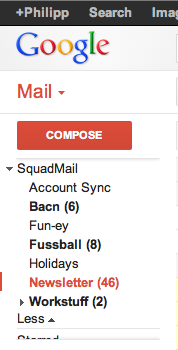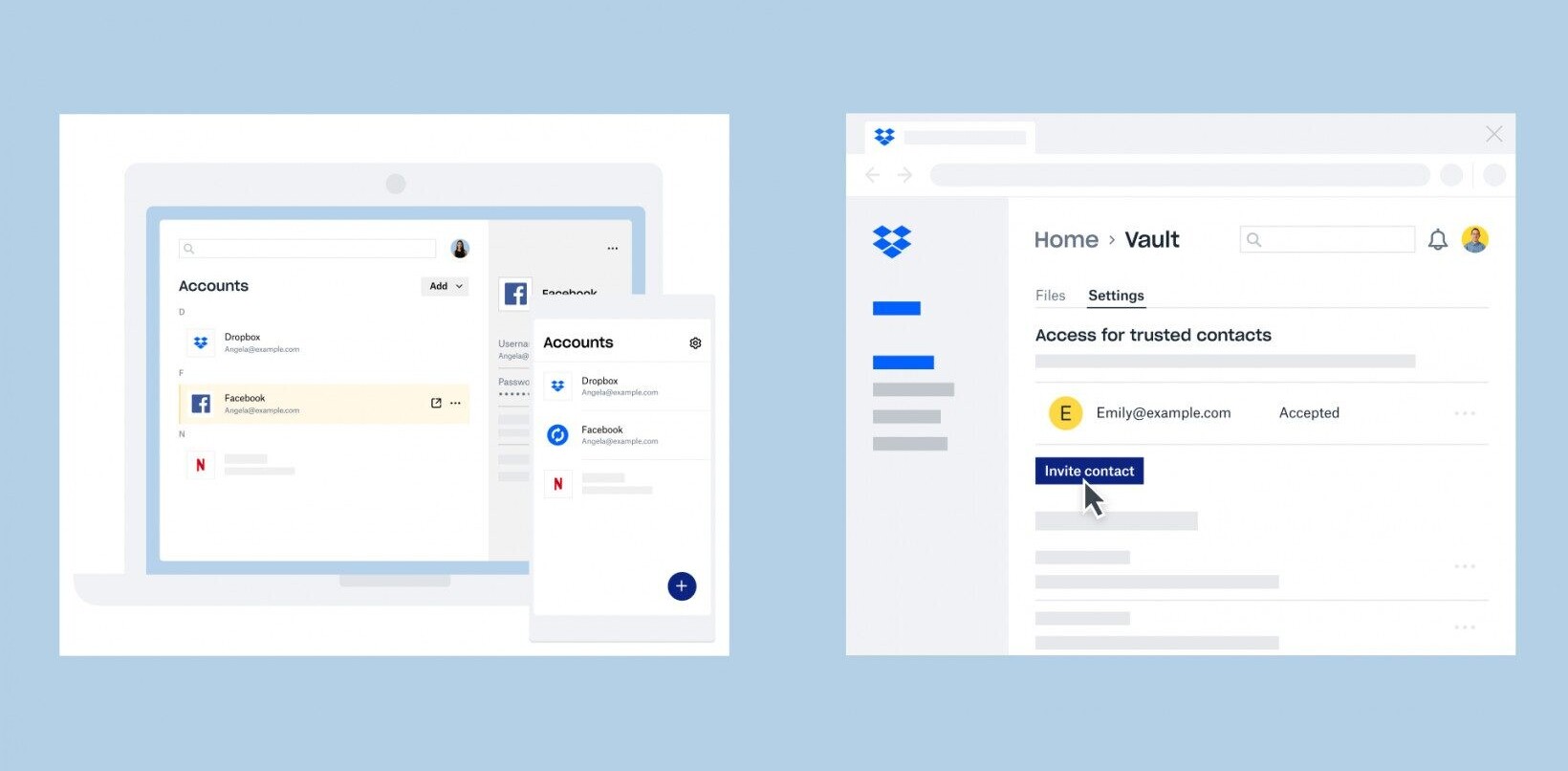
Here at The Next Web, we’re pretty hot on all things conducive of ‘getting things done’. Whilst our Lifehacks channel is dedicated to getting one up on life, we’re also prone to busting out features such as the 10 best productivity apps of 2011. So when we came across SquadMail, well, our hearts skipped a few beats.
Currently still in private beta, SquadMail offers an easy way to let companies and individuals share email folders with others, or otherwise set up temporary silos to capture emails you don’t want arriving at your main email address.
Here’s how it works
When you set up a SquadMail account, it will create a folder/label called “SquadMail” in your main email account – at the moment, this will work with any IMAP-ready email service, such as Gmail. Each of your subsequent shared folders will sit nestled nicely under this main folder.
Here’s the clever bit though.
Every folder you create is assigned its own email address which you can use for your own ends to capture, say, daily-deals email, social networking messages or other potentially spammy services. Another use case could be you and your housemates might be looking to rent a new flat somewhere, and this can be a good way of centralizing all your communications with estate agents.
From an enterprise perspective, it could be used to give company or department-wide access to inbound emails for temporary events such as recruitment drives.
So…what format do these bespoke email addresses take, and how easy are they to set up?
Let’s imagine your company is recruiting for a new position, and you want to set up a quick, no-nonsense shared folder for more than one person to access incoming applications. Firstly, the email address will start with whatever name you give the folder – so when you click ‘Create Folder’ you’d maybe want to call it ‘Jobs’.
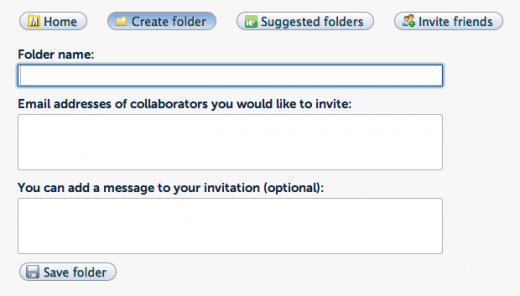
Given that a firm may want to only publicly advertise company email addresses, in this instance it may be best to have a dedicated jobs@thenextweb.com email address set up, and have it auto-forward to the jobs@box.squadmail.com address for access to be granted to others.
If you’re just looking to create temporary access to a shared email address for yourself and a few friends, then you likely would be happy just asking people to email you at a ‘newflat@box.squadmail.com’ address. The upshot of this is that it removes the need for all those disposable, single-purpose email accounts that you no doubt keep forgetting the passwords for.
In terms of setting up a new folder, it’s pretty easy. You click ‘Create Folder’, enter the email addresses of those you wish to have access, enter a personalized message if you want, and click ‘Send’.
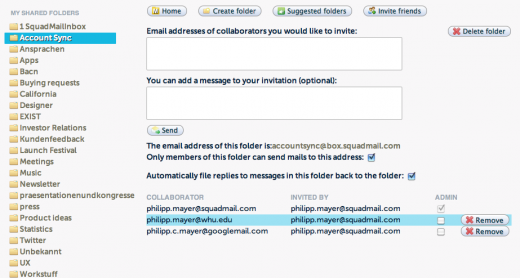
When the recipient receives an invite to access a shared folder, they must either accept or decline the invite:
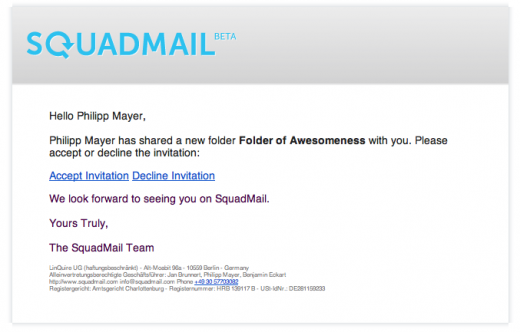
More use cases and other issues
There are a number of use-cases for SquadMail that extend way beyond what has been outlined already. For example, you can synchronize multiple email accounts for your own use – you might have a work, university and personal email address. In such cases, you can drag-and-drop the email to your “central” folder that is shared across every email account that you have.
You could also use it as a sort-of Yammer-style repository for good ideas, meaning you could just ping a quick email directly to a specific folder which your colleagues can check whenever. This removes the need to mass CC: people on emails and overload their main inbox.
Essentially ANY scenario which you wouldn’t want to use your real-name email address, SquadMail could help you with.
You may have a few more lingering questions – I know I did – and I’ll try and address these here. Firstly, the email addresses associated with each folder are currently ‘receive’ only – this means that they’re not a complete substitute for real email addresses in that you can’t send messages from them.
If one person deletes an email from a shared folder, that email will automatically be moved into the folder’s sub-folder ‘Archive’ – which is stored locally, not synced, for every individual collaborator. Also, when you remove access privileges from someone, the whole folder, including the archive, will be removed from their email server.
Meet SquadMail
SquadMail was built by Jan Brunnert, Benjamin Eckart and Philipp Mayer from Berlin, Germany. The trio had been working on a SquadMail-like application based on a different platform for a few months, when in January 2011 they realized shared email folders would be an incredibly useful addition to email. A very basic alpha version of the app was released thereafter.
In September 2011, they were awarded a grant from the German Ministry of Economics and Technology, as well as the European Union, which allows young startup founders directly out of university to build on technology products for a year without having to raise capital or take on a second job.
“From the moment the first landing page was launched, beta sign-up rates and user feedback were extremely positive and after feverishly improving SquadMail’s performance and functionality while being in a live test, the first stable version saw the light of day in Mid-February,” says Mayer. “At the same time, we also started inviting more people from outside of their extended social circles to the app and what happened next blew our minds. Without spending a single penny on marketing, and in less than 4 weeks, the inherent virality of SquadMail led to rapid user base growth and a swift internationalization with users coming from more than fifty countries already.”
At its most basic level, SquadMail is a really useful app for letting you subscribe to every newsletter under the sun without fear of drowning under a deluge of spam – all you have to do is delete your dummy folder and you’re done.
However, at its most advanced level, SquadMail could be used to transform how you and your colleagues collaborate and share information in-house. It will certainly go some way towards eliminating all those forwarded or CC’d emails that sit in your inbox.
For now, the SquadMail team is working flat-out to improve the app and it plans to leave beta within the next few months. This will also herald the launch of a subscription-based paid version of the app for professional users, “which boasts several powerful collaboration features.”
Meanwhile, you can sign-up for a beta invite here, or view the product promo video below.
Get the TNW newsletter
Get the most important tech news in your inbox each week.
